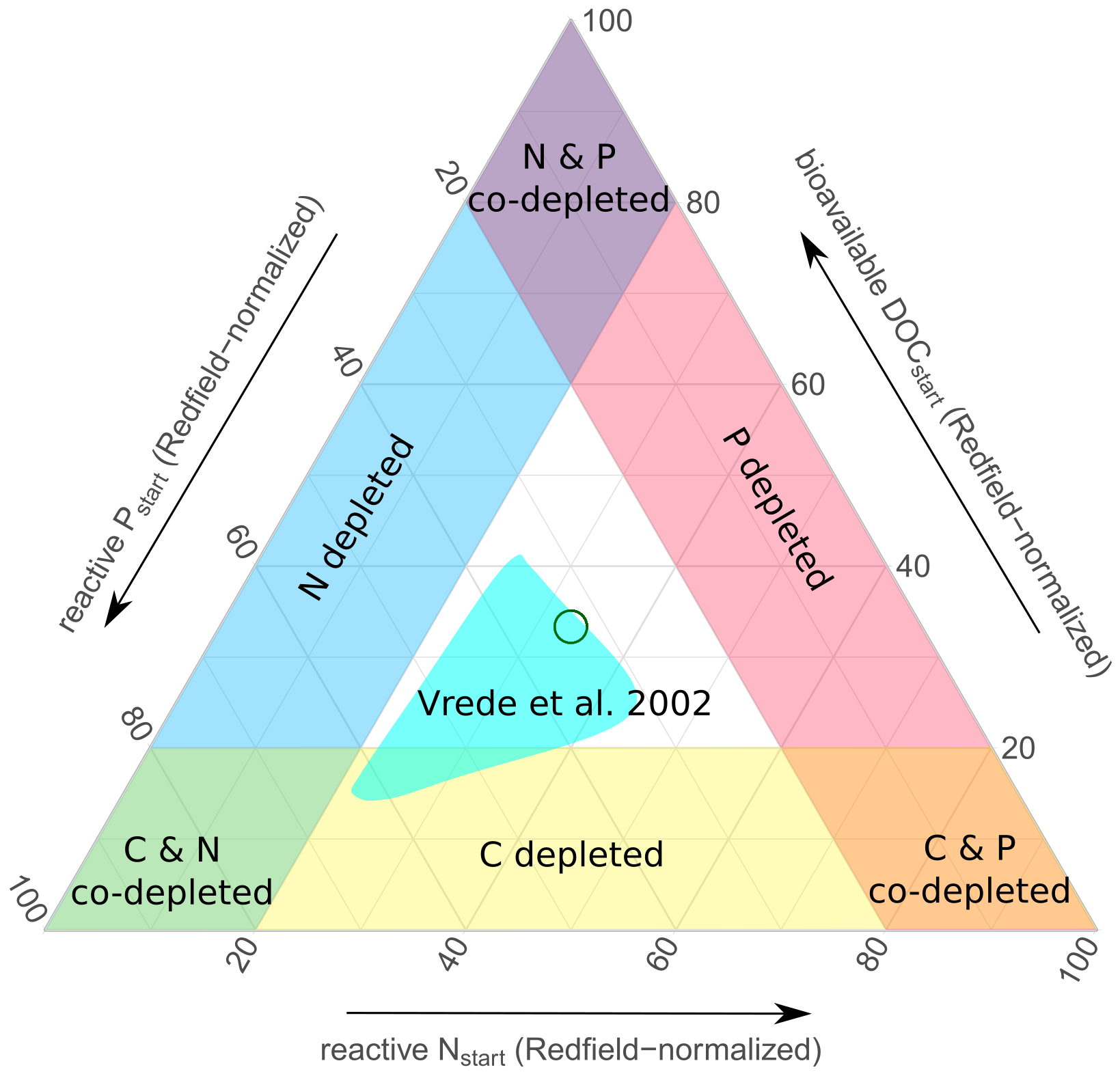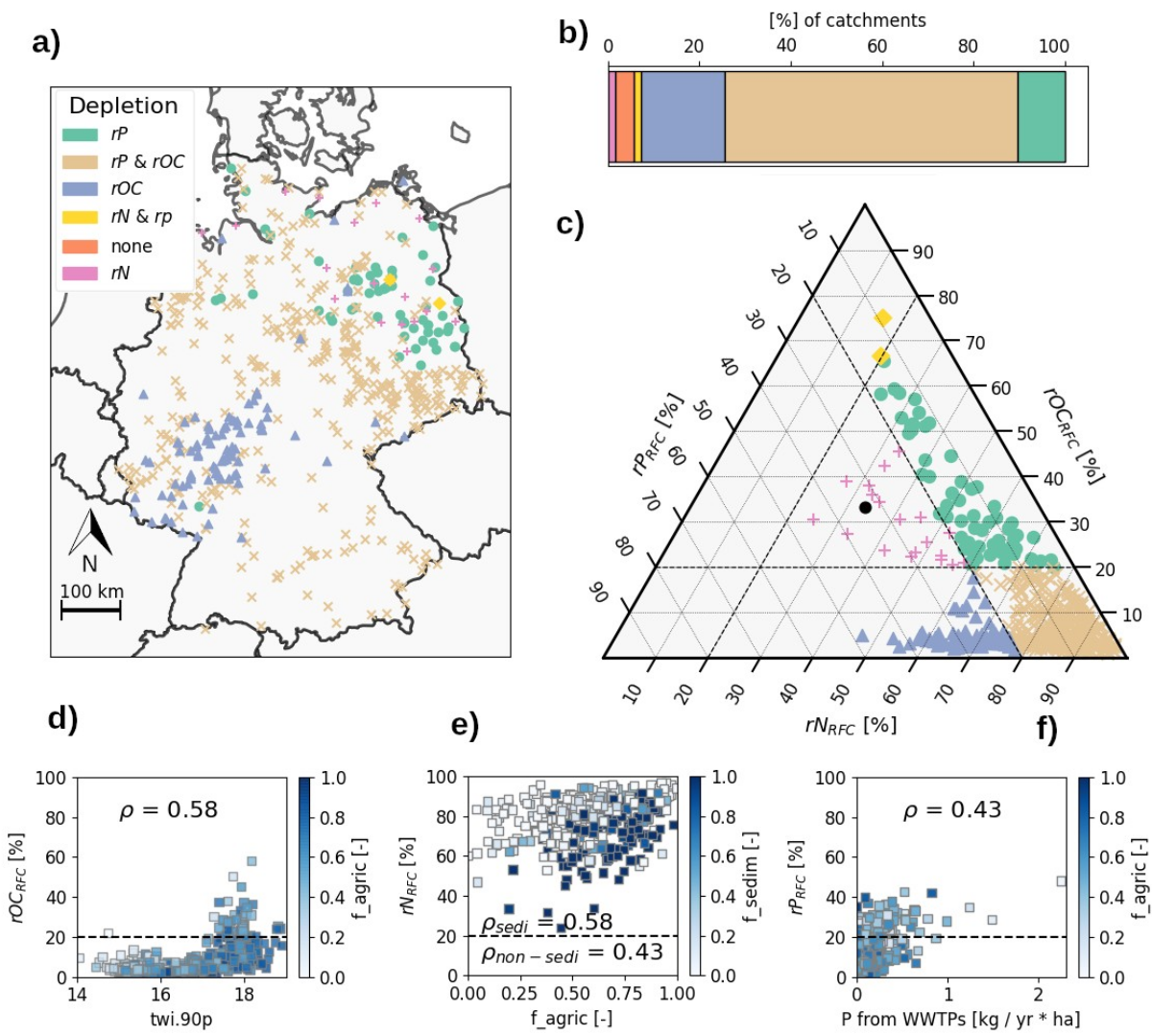CNP patterns at catchment scales
Background
The inputs of macro-nutrients (carbon (C), nitrogen (N) and phosphorous (P)) to freshwater ecosystems have been increasing throughout the last decades1. These ecosystems often connect terrestrial and marine environments and their biogeochemistry can play an important role in mediating macro-nutrient exports. As this mediation is influenced by macro-nutrient stoichiometry2, we see the need to understand what controls C:N:P patterns across freshwater ecosystems. Because those patterns are commonly studied on small scale communal levels, less is known about their behavior on catchment scales.
------------------------------------
1Vitousek et al., „Human Alteration of the Global Nitrogen Cycle“, 1997, DOI: doi.org/10.1890/1051-0761(1997)007[0737:HAOTGN]2.0.CO;2.
2Graeber et al., „Bioavailable DOC“, 2021, DOI: https://doi.org/10.1007/s10533-021-00809-4.

Objective
The main objective of this group is to identify the drivers of C:N:P ratios in freshwater ecosystems.
Research questions / hypotheses
We hypothesize that observed macro-nutrient stoichiometric ratios are the result of different biogeochmical and hydrological processes, such as nutrient mobilization and assimilation by algae, plants and bacteria. We speculate that some catchments have more stable (homeostatic) and some more variable (heteroscatic) stoichiometric ratios. As a first step, we want to classify catchments regarding those patterns and try to link them with catchment specific properties, such as land-use, soil type, vegetation or nutrient input.
Data & Methods
We use concurrently measured low-frequency records of dissolved organic carbon (DOC), Nitrate-N (NO3-N) and soluble reactive phosphorus (SRP) from around 200 German catchments along multiple phyiscal and socio-economical gradients. We use ternary plots (see figure) to visualize and classify the DOC:NO3-N:SRP ratios of those catchments and search for common patterns along/ across the above mentioned gradients. Ternary plots offer the visualization of all three macro-nutrients at a time, and also allow us to compare the ratios of catchments to those ideal for different biological groups, such as bacteria (data from Vrede et al.3, shown in the figure).
------------------------------------
3 Vrede et al., „Elemental Composition (C, N, P) and Cell Volume of Exponentially Growing and Nutrient-Limited Bacterioplankton“.
Update October 2022
(currently under review at Environmental Research Letters)
Stoichiometry on the edge - Humans induce strong imbalances of reactive C:N:P ratios in streams
Alexander Wachholz1, Joni Dehaspe2,3, Pia Ebeling2, Rohini Kumar4, Andreas Musolff2, Felipe Saavedra5, Carolin Winter2, Soohyun Yang1, Daniel Graeber1
1Department of Aquatic Ecosystem Analysis and Management, Helmholtz-Centre for Environmental
Research (UFZ), Magdeburg, Germany
2Department of Hydrogeology, Helmholtz-Centre for Environmental Research (UFZ), Leipzip, Germany
3Unit Environmental Modeling, Flemish Institute for Technological Research NV- VITO, Mol, Belgium
4Department for Computational Hydrosystems, Helmholtz-Centre for Environmental Research (UFZ),
Leipzig, Germany
5Department of Catchment Hydrology, Helmholtz-Centre for Environmental Research (UFZ), Halle,
Germany
Abstract
Anthropogenic nutrient inputs led to severe degradation of surface water resources, affecting aquatic ecosystem health and functioning. Ecosystem functions such as nutrient cycling and ecosystem metabolism are not only affected by the over-abundance of a single macronutrient but also by the stoichiometry of the reactive molecular forms of dissolved organic carbon (rOC), nitrogen (rN), and phosphorus (rP). So far, studies mainly considered only single macronutrients or used stoichiometric ratios such as N:P or C:N independent from each other. We argue that a mutual assessment of reactive nutrient ratios rOC:rN:rP relative to organismic demands enables us to refine the definition of nutrient depletion versus excess and to understand their linkages to catchment-internal biogeochemical and hydrological processes. Here we show that the majority (93 %) of the studied 574 German catchments show a depletion or co-depletion in rOC and rP, illustrating the ubiquity of excess N in anthropogenically influenced landscapes (Figure 1). We found an emerging spatial pattern of depletion classes linked to the interplay of agricultural sources and subsurface denitrification for rN and topographic controls of rOC (Figure 1). We classified catchments into stoichio-static and stochio-dynamic catchments based on their degree of intra-annual variability of rOC:rN:rP ratios (not shown). Stoichio-static catchments (36% of all catchments) tend to have higher rN median concentrations, lower temporal rN variability and generally low rOC medians (not shown).
Our results demonstrate the severe extent of imbalances in rOC:rN:rP ratios in German rivers due to human activities. This likely affects the inland-water nutrient retention efficiency, their level of eutrophication, and their role in the global carbon cycle. Thus, it calls for a more holistic catchment and aquatic ecosystem management integrating rOC:rN:rP stoichiometry as a fundamental principle.

Update March 2023
published in Environmental Research Letters as:
Stoichiometry on the edge - Humans induce strong imbalances of reactive C:N:P ratios in streams
https://iopscience.iop.org/article/10.1088/1748-9326/acc3b1
Alexander Wachholz1, Joni Dehaspe2, Pia Ebeling3, Rohini Kumar4, Andreas Musolff3, Felipe Saavedra5, Carolin Winter6, Soohyun Yang1, Daniel Graeber7
Research (UFZ), Magdeburg, GERMANY
2Unit Environmental Modeling, Flemish Institute for Technological Research NV- VITO, Mol, BELGIUM
3Department of Hydrogeology, Helmholtz-Centre for Environmental Research (UFZ), Leipzip, GERMANY
4Computational Hydrosystems, Helmholtz-Centre for Environmental Research (UFZ),
Leipzig, GERMANY
5Catchment Hydrology, Helmholtz-Centre for Environmental Research (UFZ), Halle,
GERMANY
6Helmholtz-Zentrum für Umweltforschung UFZ, Permoserstr 15, Leipzig, Sachsen, 04318, GERMANY
7Department of Aquatic Ecosystem Analysis, Helmholtz-Centre for Environmental Research - UFZ, Brückstraße 3a 39114 Magdeburg, Magdeburg, Sachsen-Anhalt, 39114, GERMANY
